 |
  |
 |
  |
Six and a half decades on the stage - G Venu e-mail: abhinayakairali@gmail.com June 21, 2020 (G. Venu, the renowned Kutiyattam performer, takes a brief trip down memory lane at his myriad experiences on the stage, on the occasion of his 75th birthday) Let me look back upon some memorable milestones during my pursuit of the arts that has lasted around six and a half decades. Hopefully, the insights gathered from everything that I had experienced, seen, watched and heard, on the stage, on the back stage and in front of the stage, both within Kerala and outside, may turn out to be useful for those who are setting out on the same path as this. My life in the arts was a free flowing journey. The journey that took me from Kathakali to Kutiyattam was the pursuit of a whole decade. It makes me feel extremely proud and fulfilled to realise that Kutiyattam, in the revival of which I had played an active role right from 1976, had gained the recognition of the UNESCO in 2001 followed by Mudiyettu (in 2010), another art form with which I was involved from 1997. The realisation that these recognitions are the result of my own efforts also makes me feel tremendously pleased. Recognising my passion to learn Kathakali, my father had started a Kalari at village in 1956. Four students other than me were also being trained in that Kalari. All the expenses of the Kalari were borne by my father who was not a rich man. We were living in a rented house at that time. 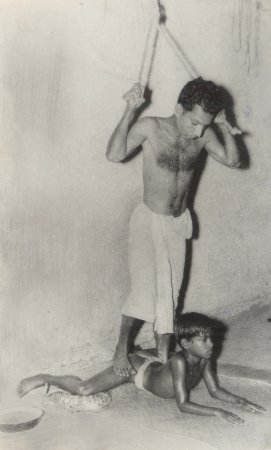 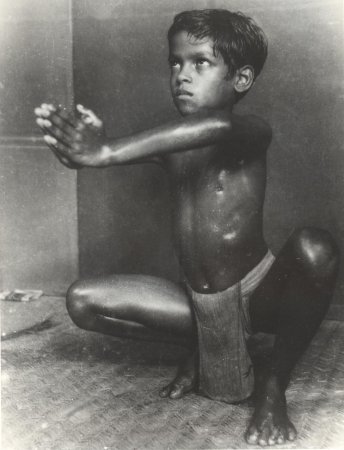 Keerikkattu Sankara Pillai and his disciple G. Venu (1956) - massage during Kathakali training The Kathakali training was tough, to say the least. Practices like the 'Chuvatu sadhakam' (practicing the footwork) maintaining a low posture and the physical exercises are tough on little children who long to run out and play. All the other students had dropped out during the three-year-long training. But my enthusiasm to learn Kathakali never waned. I had also received training in dance under Keerikkattu Sankara Pillai Asan. He taught me some items like 'Veta Nritham,' (Hunter's Dance) and 'Mayoora Nritham' (Peacock Dance). He used to tell me that this type of dance form was the creation of Guru Gopinath. During those days, I used to get many invitations for dance performances. I was the first student to enroll at Viswakalakendram, which was opened by Guru Gopinath at Vattiyoorkkavu in 1963, and continued the arduous training. During the monsoons, I used to wake up from deep sleep to the lullaby of the rain at 3 in the morning and start practice after the morning ablutions. Often, my legs would feel numb downwards from the hip. The hand gestures of Kathakali fascinated me tremendously. My biggest achievement from that period was the formulation of the Notation System to document the hand gestures of Kathakali. 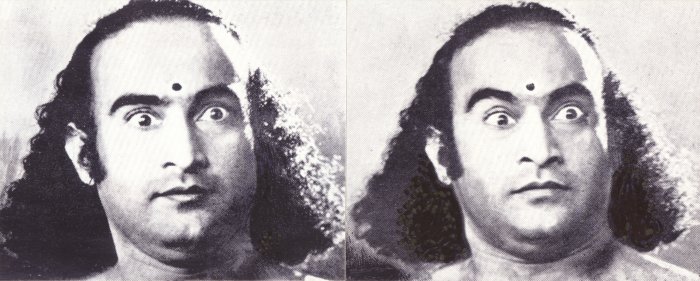 Guru Gopinath (1956) When Guruji was invited to direct the 'Ramlila' ballet in New Delhi, he took me along with him. Shambhu Maharaj and Pandit Sunder Prasad, the maestros of Kathak, were staying in rooms next to ours. The opportunity to spend a few months in their presence opened up a completely new world of abhinaya. Later, I performed the role of Hanuman in the Ramayanam ballet that Guruji had choreographed back in Kerala. I also performed the Dasavathara in the Narayaneeyam dance drama choreographed by him, performing all over Kerala. But I left the dance troupe of Guru Gopinath, moving ahead with my project to document the hand gestures of Kathakali, abandoning the good income I was making. There was no one to pay for documenting the hand gestures of Kathakali. I could meet the expenses for the documentation from the meager wages received for the job of a dance teacher at Mithraniketan, Vellanad. I had to, somehow or other, meet the expenses for my travel and accommodation while going to visit the Asans. Once I managed to enrich my compilation of the hand gestures, I travelled to Chennai (then Madras) to meet the renowned painter, K.C. S. Paniker. He examined my manuscript. "These symbols are born out of your ardent desire to document the hand gestures. Maintain them just like this," he opined. I have deep connection to each and every element of this Notation System that was derived by me. The lines are drawn by my own hand. The mudras, the hand gestures, evolve before me through those lines, blessed with the inner spirit of all the gurus who instructed me upon them. I never used to change the mudras that were drafted once, even though there were some technical hitches. I had imbibed them onto the paper through numerous sleepless nights. Later, I met N.V. Krishna Warrier, the great linguist and scholar on the arts. He wrote a foreword for a small book 'Alphabet of gestures in Kathakali' that compiled my Notation System. Those days, I used to spend one day every week at the Public Library, Trivandrum, and the British Council Library. I would refer books related to performing arts and take notes at the V.I.P. Reference Section of the Public Library from 10 in the morning till lunch break. After lunch, I would head to the British Library. 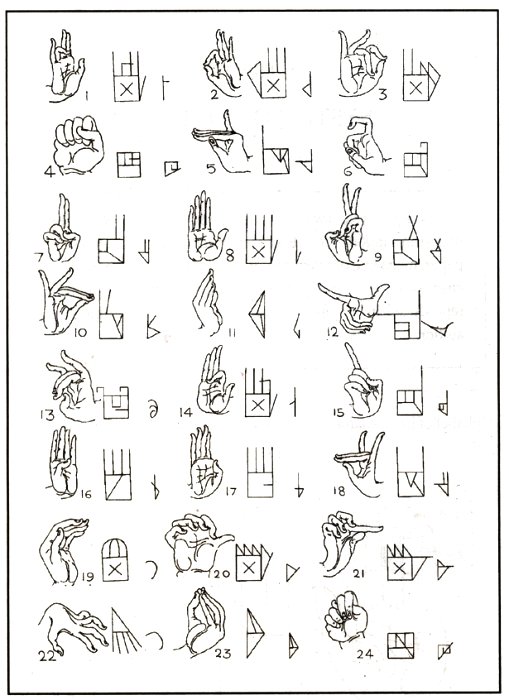  The notation system evolved by G. Venu for delineating Kathakali mudras (1968) When I had completed the documentation of more than 800 hand gestures of Kathakali, I received information that the Cultural Department of Madhya Pradesh was looking for a Kathakali performer for their new dance troupe. It was N. Mohanan, the well-known short story writer who was also handling Cultural Affairs in the Public Relations Department of the Government of Kerala who informed me of this opportunity. I applied for the post and got selected. My major incentive was the desire to learn more about the North Indian dance forms. My appointment was under the M.P. Public Relations Department. They offered a good salary with accommodation provided at the MLA Quarters. At 4pm every day, a vehicle would arrive to take us to the rehearsals at Rabindra Bhavan. The troupe included 14 dancers selected from all over India. I had to perform Kathakali only for 13 minutes. Team members who were interested to perform the folk dance forms of Madhya Pradesh like Maria or Bheel were given the necessary facilities. I signed up for everything. The days were quite hectic. When there were no programmes, I'd travel to New Delhi, taking the manuscript of my Kathakali Notation System. In Delhi, I was staying with some of my friends and met reputed art scholars like Dr. Kapila Vatsyayan, Mohan Khokar who headed the Department of Dance at the Sangeet Natak Akademi. I also travelled to Maihar and met Ustad Allauddin Khan and saw his dedicated work that immersed a whole village in music. When the Hindi poet Ashok Vajpeyi took over charge of the Department of Culture of the M.P. Government, I went over to meet him. By that time, our dance troupe had come under Madhya Pradesh Kala Parishad. I was allotted facilities including a table and a chair at the premises of Kala Parishad for pursuing my writing and the drawing of notations. At that time, Kala Parishad invited the noted theatre maker B.V. Karanth to conduct a theatre workshop. He included me in the team for training the actors. Those were the days when the notions that the contemporary Indian theatre should imbibe the Indian traditions. Around the same time, Habib Tanvir, the great maestro of theatre, conducted a workshop of Nacha, a folk dance form from the tribal people of Chhattisgarh. I had participated in that workshop as an observer. K.T. Deshmukh, the performance arts scholar and his wife had arrived in Bhopal around the same time. Through him, I met Devilal Samar, the great theatre person from Rajasthan. It was from him that I realised the relevance of puppet theatre as a medium. This later turned out to be the greatest motivation for my work towards reviving Tholpavakoothu, Kerala's traditional shadow puppet performance and Pavakathakali, the adaptation of Kathakali as puppetry.  A scene from Uttara Swayamvaram Pavakathakali directed by G. Venu (1985) K. V. Ramakrishnan, K. C. Ramakrishnan, Ravi Gopalan Nair and V. Thankappan are the puppeteers As I returned to Kerala by the end of 1975, my path was clear cut. The beginning was with the revival of the troupe of Kakkarissi Natakam in my own village. The well-known playwright G. Sankara Pillai had just been appointed as the Chairman of the Kerala Sangeetha Nataka Akademi. He published my book on Kathakali notations under the banner of Kerala Sangeetha Nataka Akademi with the title, 'Kathakaliyile Kaimudrakal' (Hand Gestures of Kathakali). The book was released by the then Education Minister C.H. Muhammed Koya with Guru Gopinath presiding over the function. Guruji said he was proud of my activities. This first book of mine received the I.C. Chacko Award of the Kerala Sahitya Akademi. When Dr. Kapila Vatsyayan toured Kerala for her research related to Gita Govindam, I was included as her main assistant. At that time, she was the Vice Chairman of Sangeet Natak Akademi, New Delhi, and a high ranking official at the Department of Culture, New Delhi. She gave me good introductions wherever we went. The dinner reception given to her by Dr. Ayyappa Paniker at Thiruvananthapuram was attended by many leading cultural personalities including D. Appukuttan Nair, Kavalam Narayana Paniker and G. Aravindan. I felt she had over-praised me in her reply to the felicitations. When I hinted this to her, she replied thus: "I thought that it will help to gain recognition for your activities in Kerala in future." It was during these tours with Kapilaji that I met the maestros including Painkulam Rama Chakyar, Mani Madhava Chakyar and Ammannur Madhava Chakyar for the first time. I had also got more opportunity to get acquainted with the art form of Krishnanattam at that time. Louba Schild and Marine Pitoeff, two French women, had started the institution Vijnana Kala Vedi at Chengannur. They requested me to associate with them as a collaborator for introducing Kerala's performing art forms to the foreigners who were visiting and also for working as an assistant in the research that was conducted by Marine Pitoeff in the masks and make-up of Kerala. I had to visit only for two days every week. A decent remuneration was also fixed. My biggest attraction to Vijnana Kala Vedi was the presence of Kalamandalam Krishnan Nair, the great maestro of Kathakali who was the master trainer there. I planned my visits according to his schedule. We were staying in adjacent rooms. I was also continuing my work with Kathakali notions at that time. Around that time, the Kerala Sangeetha Nataka Akademi, which was headed by Prof. G. Sankara Pillai, decided to conduct a dance workshop. Kalamandalam Gangadharan, who was a member of the Akademi, had raised that demand. I was invited for the organising committee meeting convened for planning the workshop. I had put forth a project for a workshop on creative dance, incorporating classical dance forms as well. It was accepted by everyone and I was entrusted with the task of drawing up the project. Within two days, I submitted the proposal for a workshop with Guru Gopinath as director. Chandrasekharan Nair, Gangadharan Master and I became the assistant directors. The workshop started every day with a lecture on Natya Sastra by Prof. K.P. Narayana Pisharody. Lec-dems by experts on performing art forms would be held every morning. Master performers like Ammannur Madhava Chakyar, Kalamandalam Krishnan Nair, Kalamandalam Kalyanikutti Amma, Kalamandalam Ramankutti Nair and Kalamandalam Sathyabhama were some of the resource persons at the workshop. Guru Chandrasekharan Nair was entrusted with the responsibility to do a dance drama as part of the workshop. He presented 'Kumara Sambhavam,' written by Ayyappa Paniker. The noted Bharatanatyam guru Manoj Master and my wife Nirmala Paniker were among the participants of the workshop. It was at this workshop that Nirmala and I decided to document the hand gestures of Mohiniyattam as notations. It was Meher Contractor, the renowned puppetry artiste, who selected Tholpavakkoothu for the Puppetry Festival organised by UNIMA, the international organisation of puppeteers, in Soviet Union. She suggested my name as the director of the troupe led by Krishnankutty Pulavar. Our eight-member team visited Soviet Union for one week. When the Calicut University School of Drama was started in Thrissur under the initiative of Prof. Sankara Pillai, I was appointed as one of the instructors. I was given the responsibility of training the students in traditional forms of acting. The job was not at all attractive for me. I would reach the campus at 7 in the morning to start training the students, and then spend my time in the campus till almost 8pm. I quit that job before long. I had always longed to explore the art forms independently, without being harnessed by the shackles of bureaucracy. My friend, Marine Piteof who was conducting a research into the masks of Kerala's performing art forms watched Krishnanattam at Guruvayoor, as part of her research. She suggested that Krishnanattam could be included in an Arts Festival to be held next year in Europe, which focussed on 'Masks.' The project that we prepared with the permission of the Guruvayoor Devaswam was accepted. Thus, a 19 member Krishnanattam team set out for a two month long tour. I was also included in the team for conducting workshops on Krishnanattam. Meanwhile, Nirmala and I got married. As Nirmala was working as a dance teacher at the Lawrence School, Ooty, I was free of the responsibility to work for an earning. We had a daughter, Kapila. 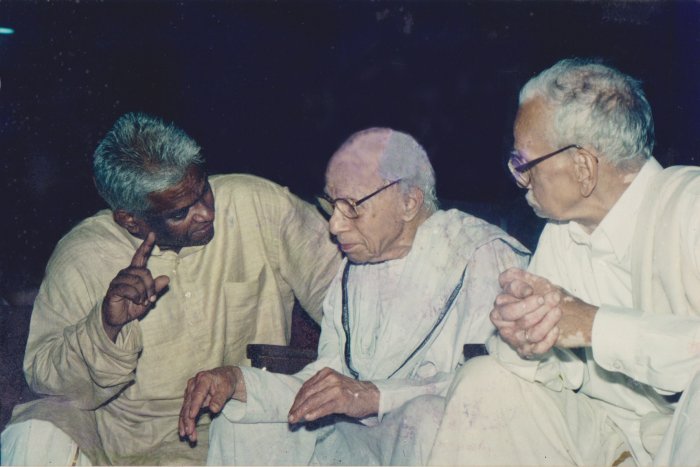 G. Venu with Prof. K. P. Narayana Pisharody and Guru Ammannur Madhava Chakyar (2002) The most important and at the same time, the most adventurous decision of my life in the arts was learning Kutiyattam at the age of 34 years. I had taken that step after resigning from a job that had offered a comfortable monthly salary. The house that I rented at Irinjalakuda did not cost much, but was hardly habitable. As a means of income, we started publishing books. The first one was 'Mohiniyattam' written by Nirmala and myself. It was very well received. Following that, we published around 10 books, including 'Mudras in Kathakali.' The publishers, in general, never show interest in books on performing art forms. Even if they do publish any, the authors are hardly given any remuneration. But in my experiences, there is a certain demand to buy and read these books, especially in English. For me, publishing is also an important source of income. Many foreigners have driven down to Irinjalakuda from Kochi International Airport in a taxi, just to buy books from Natanakairali. Once, I went to attend a lecture by Eugenio Barba, the internationally renowned theatre anthropologist and director of his Odin Teatret at Holstebro, Denmark, along with my friends, Peter Oskarson, the Swedish Theatre Director and Ma Ke (Beijing Opera director). Barba was standing at the entrance to receive the guests. He received me with the words, "Venu, I love your books !" To realise that someone like Barba had read and appreciated my books was the ultimate recognition for me. As I was browsing through the books at the Odin Teatret's book stall after the seminar, Barba came there and told me that I don't have to purchase any of the books. He presented me with the complete set of his books with autograph. Years later, in 2015, Barba came to visit me at Irinjalakuda as the guest of Parvathi Baul, the singer who is married to my younger brother, Ravi. On that occasion, I repaid my debt to him by presenting him autographed copies of all my books. Writing books is an important part of my art practice. Many rare art forms were introduced to the world through my articles. I have also tried to gain a practical understanding of all the art forms that I have attempted to revive. I have performed the steps of Kakkarissi Natakam along with Govindan Kakkan. Years ago, I had danced with the tribal people of Madhya Pradesh. In Mudiyettu, I had made the steps with Damodara Marar and helped to create a training programme by classifying the choreography. It was through these hands-on experiences that my understanding of the art forms arises. 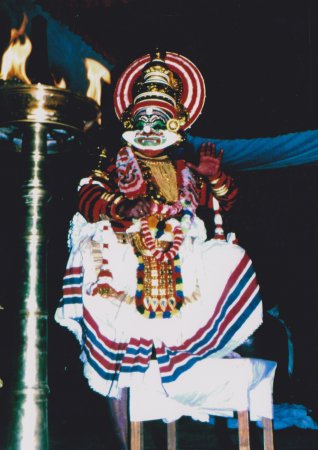 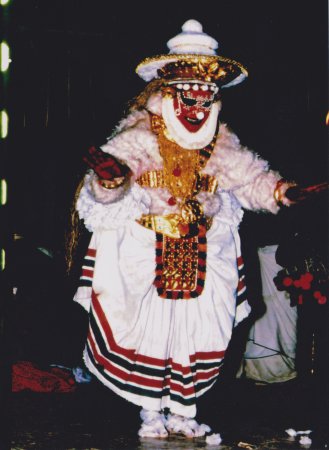 G. Venu as Ravana and Hanuman in Kutiyattam Besides learning Kutiyattam and performing it on many stages, both along with Guru Ammannur Madhava Chakyar and on my own, I could also nurture a whole new generation of Kutiyattam performers who are the disciples of Guru Ammannur. All these activities happened within three decades. In 2012, I bade good bye to the stage of Kutiyattam, putting an end to my half century long life of performance. The last role that I performed on stage was that of Surpanakha of Kutiyattam, in a documentary about my daughter Kapila, directed by Sanju Surendran. I could continue to perform for a few more years. But age is a major factor for a performer. It will keep sucking out the energy which is the primary necessity of an actor. I possess a highly satisfactory life on stage, on looking back. Even though I had never given much focus to performing on stage throughout my life in the arts, there have been many an occasion that was worthy of cherishing. I can never forget the moment when Krishnan Nair, the school champion, came forward, enthralled after watching my performance of Mayoora Nritham (Peacock Dance) and put the garland of medals he had won around my neck. Another heartening experience was when Karthyayani Amma, wife of Kathakali maestro Guru Chengannur Raman Pillai Asan came to the green room to meet me after performing the role of Hanuman in Guru Gopinath's Ramayanam ballet and told me that she felt as if Hanuman had grown as tall as the sky. When I was with the dance troupe of Madhya Pradesh Cultural Department, we performed our dance drama 'Heart of India,' at the Silver Jubilee programme of a school in a small Madhya Pradesh town. Just before the programme started a huge ruckus broke out as a group of students were denied entry passes. It was the land of the goons. Stones started to get pelted at the stage. Just a few minutes before the programme started, Vinod Chopra, our director who was to open the event with his Surya Nritha (Sun Dance) came running to me. "I have a terrible stomach ache. Venu, you should do the Surya Nritha instead of me." Surya Nritha was choreographed in the Kathakali style. Chopra had learnt Kathakali for some time under Guru Kunchu Kurup. He used to say that no one but himself could do the Surya Nritha properly. Anyway, we had to start the programme. The audience was beginning to get restless and even started booing. I was already in the midst of the make-up for the next item, which was Gandharva Nritha. Chopra said that I just need to wear his head gear and placed his head gear on me. After doing this, Chopra left for the Guest House. I was stunned for a second. I had never rehearsed that part even once. My colleagues in the troupe were looking at me piteously. The first person to enter the stage was sure to get a welcome of stones. According to the nature of the local people, even bullets could be fired. Chopra who was from Madhya Pradesh, had backed out realising the danger of the situation very well. Gathering all my courage and after praying to all the masters in my mind, I stepped onto the stage. The Sun, came out of the Mount Vindhya, to the morning ragas composed by Ali Akbar Khan in sarod and sitar. I rose, holding the Surya Mudra and moving my eyebrows alone, with a soft smile on my lips. The audience welcomed the Sun with a huge applause. The two-hour-long programme concluded successfully. All the members of the troupe opined that from then onwards, I should perform the Surya Nritha. But I never put forth such a claim. 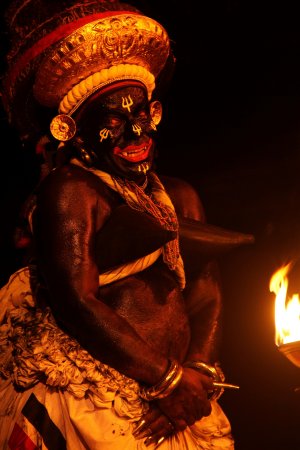 G. Venu as Surpanakha in Surpanakhankam Kutiyattam An annual conference of the SPIC-MACAY was held at the Engineering College in Bhopal, with 'Thoranayuddham' Kutiyattam by Guru Ammannur and team as the evening's performance. A demonstration was also scheduled for the morning. It was decided early on that the demonstration would be done by us, as Guru Ammannur was performing Ravana's role in the evening. But following the demands made by some of his fans, Guruji agreed to perform Sugriva's 'nirvahana' (flash back) as part of the demonstration in the morning. His performance at the demonstration was excellent, but that made him exhausted too. It was also the peak of summer with soaring temperatures. Guruji swooned when going to wash his hands after lunch. Luckily, our team members were with him and they prevented him from falling down. The doctor suggested complete rest for that day. Kutiyattam was scheduled from 12.30am till 3am. Before that were the performances by other maestros, like Kathak by Birju Maharaj and Manipuri dance by Singhajit Singh. By 8.30, I paid obeisance to Guru and started my make-up. The other performers were Pothiyil Ranjith Chakyar (Hanuman), Sooraj Nambiar (Vibhishanan), Ammannur Rajaneesh Chakyar (Sankukarnan) and Kapila (Vijaya). The audience members included Dr. Kiran Seth, Dr. Sudha Gopalakrishnan, Dadi Pudumjee and many others. Kutiyattam started without informing the audience that Guru Ammannur was not performing. The photos that appeared in the next day's newspapers captioned as Guru Ammannur Madhava Chakyar's Ravana were that of mine! 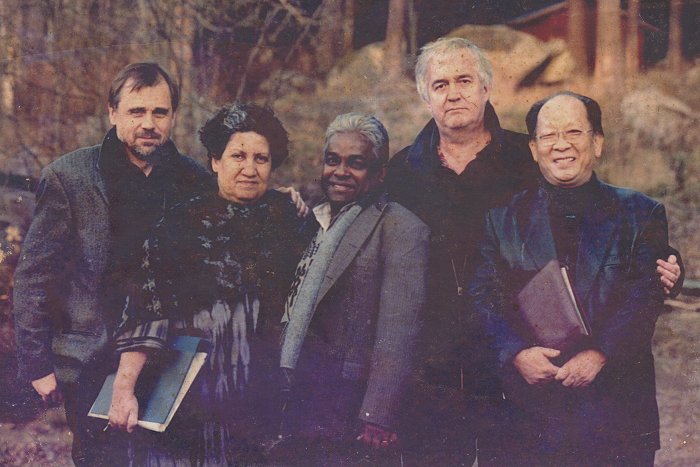 Peter Oskarson (Swedish Director), Manuela Soeiro (Theatre Director from Africa), G. Venu, Henning Mankell (Swedish writer) and Ma Ke (Beijing Opera Director) during the World Theatre Workshop in Jarvso, Sweden (1999) A four-day-long performance of Kutiyattam was scheduled in Sweden as a precursor to the World Theatre Project. The aim was to introduce the art form of Kutiyattam. The venue was at Orion Theatre in Stockholm. As I was elected as one of the four directors of World Theatre Project, Thoranayuddham and Surpanakhankam Kutiyattam were to be performed with ample importance given to me. Each Kutiyattam was performed alternately through the four days. In Thoranayuddham, I performed the role of Ravana and that of Surpanakha in Surpanakhankam. Other roles were performed by Ammannur Kuttan Chakyar (Hanuman), Sooraj Nambiar (Vibhishananan), Pothiyil Ranjith Chakyar (Sankukarnan) and Kapila (Vijaya). In Surpanakhankam, there were Sooraj Nambiar (Srirama), Usha Nangiar (Lalitha), Kapila (Sita) and Pothiyil Ranjith Chakyar (Lakshmanan). On the first day, as we were coming to the theatre, a whole army of reporters were waiting to meet me. All the four days saw house full shows. Lina Lindel, who was the producer for the World Theatre Project told me later that many people had returned without getting tickets for any of the shows. Then, a proposal came to include Kutiyattam at the Royal Tropical Museum, Amsterdam. Felix van Lamsweerde, curator of the Museum, arrived in Irinjalakuda to discuss about that project. He saw all the Kutiyattam performances that are usually performed. Finally, he selected the role of Srirama of Balivadham, with a mizhavu in the background as the exhibit for the Museum. Balivadham Kutiyattam was also selected to be performed at the Holland Festival that year. It was also decided to document the make-up of Srirama right from the beginning and a special green room was arranged for the filming. The next day after the performance, they took the mold of my legs and that of the hands showing the mudra of Srirama, for the exhibit. This exhibit was included at the Royal Tropical Museum's exhibitions for 15 years. Next to the exhibit, a video of Balivadham Kutiyattam performance with Guru Ammannur as Bali and me as Srirama was also displayed. Following the recognition of many performing art forms as the intangible heritage of humanity, the UNESCO had organised a festival of these art forms along with the General Council of the UNESCO held in Paris. Kutiyattam was to be staged on the first day of the festival. The troupe was led by Dr. Sudha Gopalakrishnan, who had submitted the file on Kutiyattam for the consideration of the UNESCO. The event began with the Navarasabhinaya by Guru Ammannur. Following that, Surpanakhankam Kutiyattam was performed with Kalamandalam Sivan Namboothiri (Srirama), Margi Usha (Sita), Margi Sathi (Lalitha), Margi Sajeev (Lakshmanan) and myself as Surapanakha, the demoness. The percussion was led by P.K.Narayanan Nambiar, Kalamandalam Easwaranunni, Kalamandalam Rajeev and Kalanilayam Unnikrishnan. I consider it a greatest fortune to have obtained the opportunity to perform at the venue which gave international recognition to Kutiyattam. I was selected as the Visiting Faculty at the Intercultural Theatre Institute (ITI) in Singapore a few years before retiring from the stage of Kutiyattam. Those days, that institution was known as TTRP. For me it was the beginning of an entirely new life. Teaching, that too teaching creatively, was an important part of creativity. They needed to incorporate a two month long module of actors training that combined Kutiyattam and Natyasastra, for their three year long course. I suggested that there will not be a pre-prepared syllabus. And there will be no written examination. I told them that I will be teaching only hundred percent practical acting training. I started with a programme that combined elements from Kutiyattam and Natyasastra along with the experiments that were conducted at the ancient Kodungallur Kalari. Slowly, it was developed into the training programme of 'Navarasa Sadhana.' As part of the programme, the students were also given training in items of Kutiyattam including 'Padappurappadu,' and 'Parvathi Viraham,' by Kapila Venu, Pothiyail Ranjith Chakyar and Sooraj Nambiar. After two years, a similar training programme was started at the National School of Drama, New Delhi. I also conduct sessions of Navarasa Sadhana at Natanakairali, during my free time. Navarasa Sadhana contains the essence of all art forms that I have experienced. The programme keeps evolving over time, every year, incorporating the necessary changes required by changing times. Later experiences have proved that this programme has been found to be highly successful in crafting excellent actors. 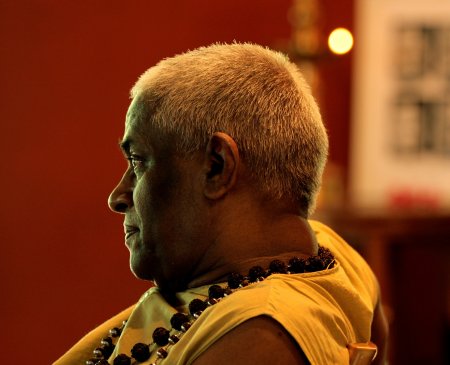 G. Venu I have absolutely no regrets regarding my activities in the world of art so far. Neither do I have any exceeding pride. My biggest satisfaction in life is that I have worked at only what I really enjoyed. Now, I am seventy five years of age. Even though I have no serious health issues, I am beginning to feel a little bit of forgetfulness. I do not know if my mode of working presents a role model to others. However, my masters and other artistes were rare examples in their own genres of art. Moreover, they were almost the last links in that tradition of performing arts that had existed in our country down the centuries. Their life-long dedication to the arts was something that might never get repeated in this world. Let me dedicate these notes before the sacred memory of my masters including Keerikkat Sankara Pillai, Guru Gopinath, Guru Chengannur Raman Pillai and Ammannur Madhava Chakyar as well as my worthy colleagues, Govindan, Chellayyan, Sreedharan, Pazhoor Kunjan Marar, Pazhoor Damodara Marar, P.K. Madhavan Pillai and Koonathara Krishnankutti Pulavar with the deepest obeisance. It is the workshop series of Navarasa Sadhana that has given me the biggest satisfaction. Around 600 persons have received acting training through the 32 workshops conducted so far. The students of National School of Drama and ITI have received training in Navarasa Sadhana. Many of them, including Abheesh Sasidharan, Moon Moon Singh, Kalyani Mulay, Vivek Kumar, Lap Deong and Sonali Bharadwaj among many others are active practitioners and performers. Following widespread demand, Natanakairali organised a series of workshops. I was able to procure a long line of illustrious artistes through the Navarasa Sadhana including the actor Adil Hussain, Sandya Mridul, Kani Kusruthi, Kannada film actor Swetha Srinivasan, Kathak dancer Sanjukta Wagh, Odissi dancer Sonali Mishra, Kuchipudi guru Vyjayanti Kashi, dancers Dr. Katyayani Ganti, Payal Ramchandani, Sreelakshmi Govardhanan, Prateeksha Kashi, Bharatanatyam dancers Chitra Sundaram, Shijit Nambiar, Parvathy Menon, Renjith and Vijna, Shyamjith Kiran and Viraja, Meera Sreenarayanan, Tanya Saxena, Mathangi Prasan and Mira Balachandran Gokul. Almost every day, I'd be teaching someone. Navarasa Sadhana is the greatest treasure, the greatest gift that I ever received out of my researches and long interactions with different art forms. Navarasa Sadhana has now become a well-known actor training programme. It has become part of the daily practice for many actors in India and abroad. It is exciting that so many possibilities could be derived from developing just a small element from the actor training programme that was evolved by masters many, many centuries ago and imparting contemporariness to it. Natyasastra should be subjected to the independent interpretation of the ordinary actors. That is the need our times. 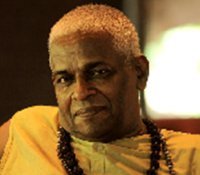 G. Venu is a performer, researcher and has invented a dance notation system for delineating mudra in dance and theatre in Kerala. He has also devised 'Navarasa Sadhana' module as a transformative process for artistes seeking a deeper insight to the depths and diversity of human emotions. He is the Chairman, Natanakairali, Ammannur Chakyar Madhom, Irinjalakuda. Comments * I have always been an ardent admirer of G.Venu for his determined dedication to his chosen field. Probably I must be one of the first artistes who bought his book Kathakali Mudra notation. I had sent couple of students to attend his Navarasa Sadhana classes and happy to say, they all benefited out of it immensely. Narthaki should be congratulated for publishing an illustrious account of Venuji's life in a nutshell. His great legacy is inherited by his equally illustrious daughter Kapila; she is his best contribution to the world of Chakyar Koothu and Koodiyattam. My best wishes on his 75th birthday and pray to the almighty that his legacy continues through his daughter and several disciples around the globe. - V.P.Dhananjayan (July 14, 2020) * I most thoroughly enjoyed Venu's very informative article on his long career in the performing arts. I have known Venu for some years, but was still not aware of his such eventful years in multiple dance disciplines, that he has described in such an undertone. A life-long dedication has seen many fulfillments such as UNESCO’s recognition of Kutiyattam as "World's Intangible Heritage". Indeed, Venu's modesty underplays his not mentioning his signal bilingual publication of ‘Ramayana Samksepam’, the sourcebook on Kutiyattam, under the aegis of National Cultural Fund as sponsored by Dr. Kapila Vatsyayan, supported by the video illustration of 'Sita' by Kapila Venu. And his path-breaking work in promoting Kerala's puppetry all over the world. I wish he would publish a concise video-version of his monumental work ‘Navarasa Sadhana’ that he is conducting over the years for the widest possible circulation. - Dr. Utpal K Banerjee (July 11, 2020) Post your comments Pl provide your name and email id along with your comment. All appropriate comments posted with name and email id in the blog will also be featured in the site. |